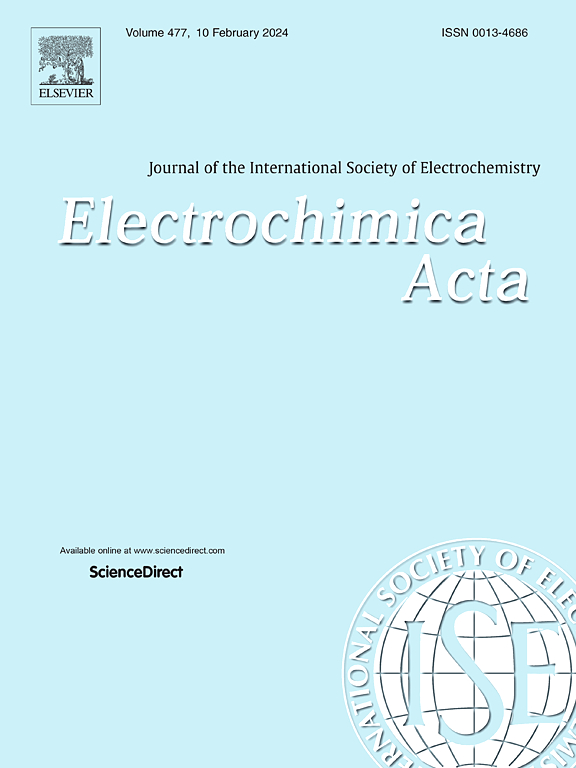Design and synthesis of hybrid Mo-doped Bi₂O₃ nanomaterials as an efficient electrodes for high-performance supercapacitors
IF 5.5
3区 材料科学
Q1 ELECTROCHEMISTRY
引用次数: 0
Abstract
The major concern with efficient, supercapacitors still lies in the increase of capacitive performance and maximum stability. Consequently, in most cases conventional materials are unable to fulfil the required condition and characteristics for better performance. In present work, the Mo-doped Bi₂O₃ hybrid nanomaterials were prepared as a superior electrode material for supercapacitors to address the current issue. The Pure Bi₂O₃ and (1%, 3% and 5% wt.) MoO₄-doped Bi₂O₃ nanomaterials were prepared via sol-gel methodology. The synthesized nanomaterials were confirmed by spectral, microscopic and X-ray characterization techniques. The SEM analysis confirmed the formation of refined cubes as defined for the nanomaterials. Cyclic voltammetry, galvanostatic charge discharge, and electrochemical impedance spectroscopy were utilized to assess electrochemical excellence of prepared nanomaterials. Furthermore, the pure Bi₂O₃ depicted capacitance value of about 548 F/g, whereas 1% MoO₄@Bi₂O₃ showed capacitance about 675 F/g. Moreover, the 3% MoO₄@Bi₂O₃ nanomaterial showed excellent performance with specific capacitance of 988 F/g at 1 A/g. The 3 % MoO₄@ Bi₂O₃ electrode was also tested for columbic efficiency. The electrode material explored significant efficiency about 89% at 2500th cycles. The present research visualized that the 3% MoO₄@Bi₂O₃ is a reliable electrode material for the advancement in next generation supercapacitors with better capacity, stability & scalability.
设计和合成掺杂钼的混合双₂O₃纳米材料作为高性能超级电容器的高效电极
高效超级电容器的主要问题仍然在于提高电容性能和最大稳定性。因此,在大多数情况下,传统材料无法满足提高性能所需的条件和特性。针对这一问题,本研究制备了掺杂钼的 Bi₂O₃ 混合纳米材料,作为超级电容器的优良电极材料。通过溶胶-凝胶法制备了纯 Bi₂O₃和(1%、3% 和 5% wt.)掺杂 MoO₄的 Bi₂O₃纳米材料。合成的纳米材料通过光谱、显微镜和 X 射线表征技术进行了确认。扫描电子显微镜分析证实,纳米材料形成了细化的立方体。利用循环伏安法、电静电荷放电法和电化学阻抗光谱法评估了所制备纳米材料的电化学性能。结果表明,纯 Bi₂O₃的电容值约为 548 F/g,而 1%MoO₄@Bi₂O₃的电容值约为 675 F/g。此外,3% MoO₄@Bi₂O₃纳米材料性能优异,在 1 A/g 时的比电容为 988 F/g。3 % MoO₄@Bi₂O₃电极也进行了电容效率测试。该电极材料在第 2500 次循环时的效率高达 89%。本研究表明,3% MoO₄@Bi₂O₃是一种可靠的电极材料,可用于下一代超级电容器,具有更好的容量、稳定性和可扩展性。
本文章由计算机程序翻译,如有差异,请以英文原文为准。
求助全文
约1分钟内获得全文
求助全文
来源期刊

Electrochimica Acta
工程技术-电化学
CiteScore
11.30
自引率
6.10%
发文量
1634
审稿时长
41 days
期刊介绍:
Electrochimica Acta is an international journal. It is intended for the publication of both original work and reviews in the field of electrochemistry. Electrochemistry should be interpreted to mean any of the research fields covered by the Divisions of the International Society of Electrochemistry listed below, as well as emerging scientific domains covered by ISE New Topics Committee.
 求助内容:
求助内容: 应助结果提醒方式:
应助结果提醒方式:


